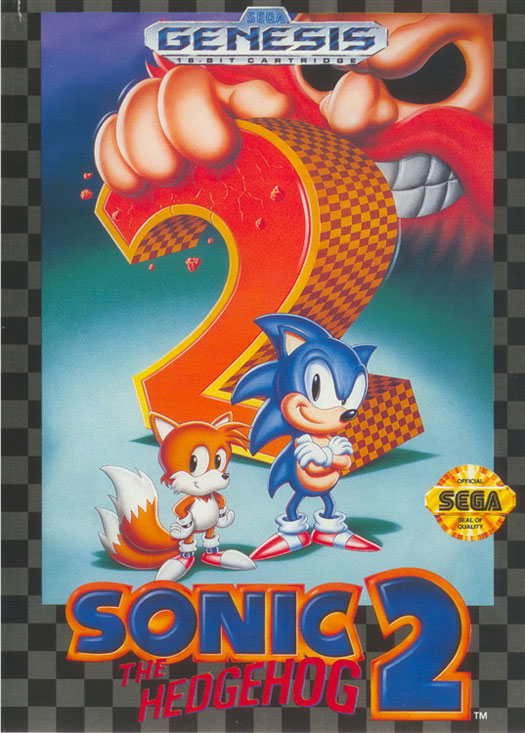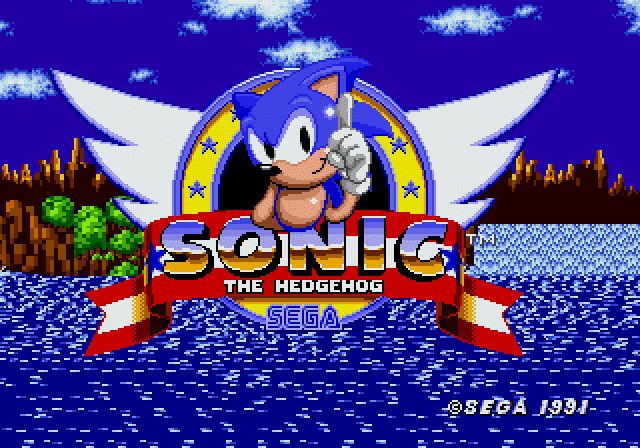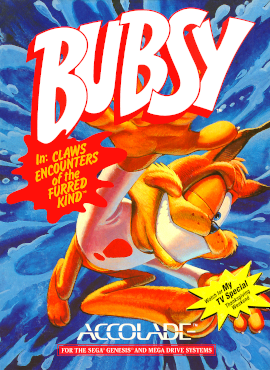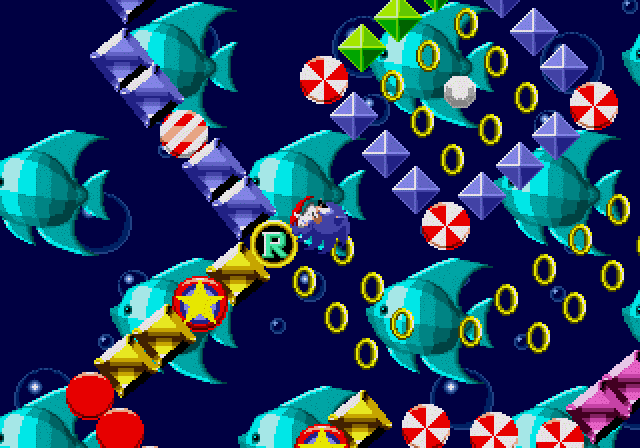Well, it’s that time of year again: time to celebrate Sonic’s 21st
birthday. Yes, my last post was a review of Sonic 4: Episode 2, but, as these
are the only main Sonic games I have yet to review, it needed to be done
and there was no better time than now. Not to mention that it’s basically a
rule that I must have an unhealthy number of Sonic-related posts each year. You may notice that this post is labeled "Part 1". As I wrote this, I realized that to place my reviews for all four games in a single post would make this ridiculously long; thus, I'm going to put out the Sonic 1 and 2 reviews right now and post up the reviews of Sonic 3 & Knuckles and CD on June 23rd, Sonic's actual birthday. But
before we get into the reviews, let’s go back in time to an era before
green eyes and physics, before Ryan Drummond and Jason Griffith, before
Werehogs and boosting to win, so that we can enjoy a little history lesson.
A long time ago in a decade far, far away, a video game company called SEGA
forayed into the home console business that Nintendo's Famicom/NES revitalized. Their
console was called the SEGA Master System in the American and European markets, and while it was technically
superior to Nintendo's console and had its more popular games, such as Phantasy
Star and the Alex Kidd series, it failed to achieve the NES' popularity by a long
shot, at least outside of Europe. Down but not out, SEGA released a successor to the
Master System in 1989 (1988 in Japan). It was called the Genesis (or Mega
Drive, if you live in Japan or Europe) and its 16-bit processing power made
Nintendo's console look like crap by comparison. However, the new console didn't see
much success until SEGA decided to create a mascot for it, and thus, Sonic the
Hedgehog was born and would go on to spawn a massive number of games, four different cartoon series, an
OVA (or movie, if you prefer), an ongoing Archie comics series and a number of "inspired" clones and imitators that tried to cash in on the whole "extreme wacky animal" thing, often with limited success...and game quality. Some were more blatant than others.
 |
| Top: Inoffensive "inspiration", although that may be the ugliest thing I've ever seen. Bottom: Something someone should have gotten sued over. |
Sonic was meant to compete with Nintendo’s ever-endearing plumber, Mario.
The series did a pretty dang good job of that, as Sonic was the physical embodiment
of 90’s TOTALLY RADICAL EXTREEEEEME. This kid wasn’t slow and fat like that lame-o
plumber dude; this way past cool ‘hog had an attitude. He wasn’t taking any crap
from Dr. Robotnik…or…Eggman…or…whatever you want to call him, and true to his
name, he was freaking fast. The four – well, technically five – main games
that came out during this era capitalized on this by providing innovative gameplay
mechanics and level design. Even today, these games are considered by many to
be some of the best that the series has to offer and even some of the greatest
2-D platformers of all time. So, I’m going to use this celebration as an opportunity to see exactly
what made these games great while Sonic has his first legal keg party.
Well, I guess it technically isn't legal for about another week, but hey, I guess Sonic just doesn't care. Hooray.
Well, I guess it technically isn't legal for about another week, but hey, I guess Sonic just doesn't care. Hooray.
---------------------------------
.jpg/250px-Sonic_the_Hedgehog_boxart_(Genesis).jpg) |
| Sonic the Hedgehog |
Well, let’s start with the original game, released in 1991. As one would expect, this game laid a lot of the groundwork that most future games in the franchise would follow. The plot of the game – well, what little plot it has - is that the nefarious Dr. Eggbotnik is capturing small animals and using them as organic batteries for his own robots, which he will use to take over the world. Enter Sonic, our cool blue dude with an attitude and the speedy shoes and the...okay, I’ll stop now. Anyway, Sonic doesn't like what he sees and decides that Dr. Robeggman must be stopped. Since it's an old Genesis platformer, you really can't expect much emphasis on plot. However, what is kind of interesting is that the game could be considered to have a subtle moral about environment conservation, which would actually carry over into the 1993 Saturday morning cartoon. At a time when shows and movies such as Captain Planet and FernGully: The Last Rainforest were relentlessly shoving this moral down our throats with all of the maturity, tactfulness, unpretentiousness and intelligence of a Cranberries song, it's nice to see that something tried to use a little bit of subtlety in conveying the message. Oh yeah, this was copied, too. Poorly.
 |
| I honestly wonder if this game could have lost a plagiarism lawsuit. Seriously, "Dr. MACHINO"? |
Visually, Sonic 1 holds up…okay. Even when compared to later Sonic games on
the Genesis, Sonic 1’s visuals don’t stand out quite as much, not being as
bright, vibrant and colorful as what we would see later on. Green Hill Zone is
the closest this game gets, but eh, none of it really looks bad, and I’d say a
lot of the character and enemy sprites are very impressive given the game’s
age. The soundtrack is also very good and memorable, with some highlights being Star Light Zone's and Scrap Brain Zone's tracks, although, again, it’s not
quite as good as what would see – ehm – hear in later games.
Of course, if that were all that Sonic 1 had going for it, we wouldn't have
much to talk about, would we? Before we talk about the main gimmick of the
game, let's go over some basics. There are six Zones (worlds, basically) in the
game with three Acts (levels) in each. The goal of each act is just to get to
the end. However, Dr. Machino’s robots and numerous obstacles and traps will be
standing in your way. One hit and you're dead - that is, if you don't have any
Rings. Rings can kind of be thought of as life energy for Sonic, although
they're not health in a conventional sense. There are plenty of Rings to get on
any given path you can take in each level, and as long as Sonic is holding onto
at least one, he can take a hit without dying. However, you will lose all Rings
you have been holding onto if you get hit, in which case you need to get as
many back as you can before they disappear. There is actually a shield power-up
which creates a protective barrier around Sonic that will absorb one hit of
damage. Other power-ups include the classic platformer
staple of invincibility, which pretty much speaks for itself, and Power
Sneakers, which briefly let Sonic run even faster than normal. At the end of
the third Act of each Zone, you will fight against Dr. Wilybotnik in one of his
many machines. Bosses in Sonic 1 are far from the most challenging you’ll ever face,
but are nonetheless fun to tear apart.
Well, that’s the basic gist of things. Anyway, the most prominent gimmick
of the Sonic series is that Sonic is the fastest thing alive. As such, you can
probably expect a significant amount of speed in this game. This is at least partially
thanks to the physics. As Sonic runs and especially when he rolls down slopes (done by pressing down on the D-Pad),
he gains momentum and maintains inertia even when the player isn’t actively
controlling him, and levels are very sloped and angled to make use of this. Not
only does this allow for some cool tricks, but movement feels absolutely fantastic.
The sense of speed is definitely there and results in some very satisfying
moments. However, one thing that you will be using this for a lot is to make it
to different areas in each level, which brings me to another way that Sonic 1
really innovated. Up to this point in time, most platformers had fairly
straightforward level design. There may have been some secrets here and there,
but they mostly kept you on a set path. Sonic 1, on the other hand, features gigantic
and complex levels and a significant element of legitimate exploration. There
are many different ways to go through each Act, and it adds a lot of replay
value to try to take paths that you didn't take the last time through the game.
At the time, I doubt the stages of this game could have been anything less than
revolutionary, but even today, they just feel huge and are a joy to run through
and explore.
Now, gaining speed is easy enough, but maintaining it is a whole other story.
See, the classics were built upon the idea that speed is most satisfying when
it’s a reward for skillful play. The game was obviously designed with this in
mind; even getting hit by an obstacle or enemy will get you knocked back,
completely destroying whatever momentum you already had, and this also comes
into play in the level design. Good examples can be seen in areas of Marble Zone
and Spring Yard Zone, which feature treacherous platforming segments that will
require you to be very careful if you hope to maintain a sense of speed.
But while the speed was probably the most interesting aspect of Sonic 1 at
the time, when compared to a lot of games in the series, it does prove to be a
lot slower, not just in terms of Sonic’s top speed, but in terms of general
design. While there are still several opportunities to go fast in the game, it
tends to focus less on speed and more on straight-up platforming, at least more
so than the series’ later games. In fact, one Zone – namely, Labyrinth Zone - doesn’t
really offer any opportunities to go fast at all, at least not as far as I’m
aware. Platforming also tends to be slower-paced than what you
might expect from Sonic. Of course, I don’t think the game is bad for it. While
platforming is a bit slower and more emphasized than you might expect from a
Sonic game, in return the platforming is very complex and interesting and thus the level designs of Sonic 1 are a lot of fun in
their own right.
But…that’s not to say that everything is perfect when it comes to the
levels. Actually, there really aren’t any problems with the levels themselves;
each Act in the is game very well-designed. However, the game just feels so…disorganized,
so to speak. So, we start the game with Green Hill Zone, a simple and easy Zone
that’s pretty fast and allows players to get acquainted with the game, like any
good first stage should. Suddenly, we see a massive spike in difficulty in the
much slower-paced and platform-heavy Marble Zone. Spring Yard Zone sees things
getting a bit easier again and allows for more speed. Then, suddenly, we’re
thrown into Labyrinth Zone, the second-most difficult Zone in the game, which
is very slow due to a great chunk of it being submerged underwater and Sonic
can’t swim. And expect to do a lot of waiting around for air bubbles so you don’t
asphyxiate. And then there’s Star Light Zone, which is the fastest and possibly
even the second-easiest Zone in the game. This very awkward pacing makes going
from Zone to Zone pretty jarring and is going to be especially off-putting for
new players; it may take a couple of playthroughs to completely get into all of
the levels. Unfortunately, this is a pretty significant flaw.
Also…I really don’t care for the Special Stages in this game. For those who
aren’t in the know, Special Stages are a mainstay of the 2-D Sonic games.
Completing them usually yields a Chaos Emerald, of which there are either six
or seven, and getting all of the Chaos Emeralds will get you a better ending
and sometimes even some other cool stuff, which will be touched on in later
reviews. Special stages in Sonic 1 are accessed by completing a level with 50
Rings, and are rotating mazes filled with bumpers, blocks that reverse the
stage’s rotation, blocks that speed up the stage’s rotation, blocks that slow down
the stage’s rotation, and misleadingly named "GOAL" blocks that throw
you out of the stage when you touch them. As mentioned before, there is a Chaos
Emerald hidden in every stage, and you have to navigate Sonic - in ball form,
meaning that you don't have full control over him - through the maze to the
Chaos Emerald without touching any "GOAL" blocks. This is…just as
frustrating as it sounds. All the bouncing around you do is bound to make you
hit blocks that reverse or speed up the stage, complicating things or even
sending you in circles, and bumpers will often send you careening into directions
you don’t intend to go in. This makes navigating these monstrosities more of a
pain than anything, not to mention that the reward for getting all of the Chaos
Emeralds in this game is pretty lame anyway. Unless you think the ending needs
more giant flowers or care that much about your score, there won’t be much
incentive to bother.
But for all of these flaws, Sonic 1 is a great game, especially for its
time. When it first came out in 1991, it was innovative in pretty much every
sense of the word, and it's still a lot of fun to play today. It's not as great
as Sonic games would get, but it's still a really good platformer that belongs
in any gamer's collection.
The Good:
+ Innovative physics for its time
+ Good sense of speed
+ Great level design
+ Great replayability
The Bad:
- Flawed Zone pacing
- Special stage sucks
- Lackluster reward for getting all Chaos Emeralds
Grade: B+
 |
| Sonic the Hedgehog 2 |
Well, with that out of the way, let’s move on to
Sonic the Hedgehog 2. Sonic the Hedgehog 2 was released in 1992 and is still
considered by some to be the very best game in the series. Personally, I’d
disagree, but that’s not to say it isn’t really awesome. The plot of the game is exactly the same as that of the first game, except for the fact that Eggman now intends to build a giant space station called the Death Egg, which is totally not a reference to Star Wars. Also, Sonic is (optionally) accompanied by his fox sidekick,
Tails. All you need to know about him is that he idolizes Sonic, he has been blessed with two tails that he can use to...fly - not that you can make use of it in this game - he’s a mechanical
genius, and he is probably the only eight-year-old with a pilot’s license…or at least I…hope he has one.
 |
| Even if it weren't for the death robots, this would be a pretty dangerous situation. |
On the aesthetic side of things, Sonic 2 is a
sizeable improvement over its predecessor. All of the Zones look great given the game’s age, being very vibrant and colorful, and they
are very visually appealing even today. The soundtrack is also probably one of
the most iconic and memorable in the entire series. It’s actually a bit
difficult to pick out which tracks are the best, because the entire soundtrack
is absolutely fantastic. However, I suppose that if I had to pick three
favorites, they would probably be Chemical Plant Zone, Metropolis Zone, and the
notoriously Inspector Gadget-esque Mystic Cave Zone.
Woo-hoo...
Moving on to gameplay, Sonic 2 maintains the same
gameplay style of Sonic 1, though, with the exception of Metropolis Zone, it
ditches the three-Act Zone structure. Zones now have only two Acts; however, in
return, there are a lot more Zones: nine as opposed to the original’s six.
Thus, you’re getting roughly the same amount of levels, but with more
diversity, so I’d say the change is a positive one. And, of course, you must do
battle with Dr. Clawbotnik at the end of each second Act. Ol’ Dr. Nut-Megg has
gotten a bit more creative this time around with his machines, which makes
bosses a bit more interesting, but they’re still not much of a challenge.
So, as a sequel, Sonic 2 should improve and expand
upon the gameplay and design of the first Sonic the Hedgehog game. Does Sonic 2
successfully do this? The answer is a resounding “yes”, especially where design
is concerned. Sonic 1 was a fairly slow game by Sonic standards and mostly
emphasized platforming. Sonic 2, on the other hand, speeds things up
considerably. Sonic runs much faster in this game than he did in Sonic 1, and
there are a lot more opportunities to make use of this speed. Chemical Plant
Zone, in particular, has several moments where it feels like a giant, speedy
joyride. Even by Sonic standards today, the sense of speed this game offers is
at times pretty incredible and makes for some really exhilarating moments. The
physics are just as great as ever, and Sonic even gains a spindash move in this
game, which allows you to curl up into a ball and charge up a speed boost,
which just makes gameplay that much more versatile. Levels are even more
gigantic than they were in Sonic 1 and usually tend to be a lot less enclosed,
which gives you even more freedom. Heck, there are still some areas in this
game that I’ve only recently discovered!
Of course, while the game is very fast, don’t
think platforming is downplayed, either. In fact, Sonic 2 balances out and even
blends both speed and platforming almost perfectly. The platforming on display
here is very good and the game contains no shortage of cool and creative ideas.
Casino Night Zone, in particular, has gimmicks and such that are based on a
pinball machine, which give Sonic’s physics an entirely new use, and Hill Top
Zone features areas where you must move fast to avoid being killed by rising
lava or even a rising floor that threatens to crush you against the ceiling.
Also, you’re still going to have to play skillfully if you hope to maintain
speed, and the Zones will only get more platform-heavy and difficult as you
keep going. Speaking of which, Sonic 2 doesn’t suffer from the flawed pacing
that Sonic 1 had: going from Zone to Zone feels very natural and there is a
legitimate sense of progression.
The Special Stage, accessed by jumping into a portal after hitting a checkpoint with at least 50 Rings in tow, is a lot better this time
around, as well. The game switches to a behind-the-back view for it, and the
goal is to collect a certain number of Rings in a half-pipe within a limited
time while avoiding bombs, which, if hit, will take away ten Rings. I mentioned
in my Sonic 4: Episode 2 review that these Special Stages have been copied by
later games to the point that they’re getting a bit tiring, but really, that’s
not the game’s fault. It is a really fun Special Stage that gets really
challenging towards the end. The only problem is that you are only going to
want to play as Sonic alone if you intend to collect all of them. Going into
the Special Stages while accompanied by Tails will cause needless frustration
due to the fact that he has his own Ring counter and he moves and jumps about
half a second after you do. Needless to say, it’s annoying and complicates
things more than it should.
Oh yeah, the reward for getting all of the Chaos
Emeralds in this game is actually pretty worthwhile. Sonic 2 marks the
introduction of Super Sonic, a super-powered version of Sonic that runs twice
as fast and is completely invincible, and you unlock him by – you guessed it –
collecting all of the Chaos Emeralds. Once you do that, simply get 50 Rings,
jump and then boom, Super Sonic. You lose Rings gradually while in your super form, and if you run out, you'll revert back to your base form. Nonetheless, it’s still a bit of a game breaker, but after
fighting your way through all of the Special Stages, it honestly feels
rightfully earned, as does the best ending of the game. Yeah, seeing Super
Sonic in the ending technically isn’t a big change, but when I first got that
ending as a kid, it felt freaking satisfying and still does to this very day.
 |
| To anyone who ever wanted more DBZ in your Sonic, here you go. Now stop writing that crossover fanfiction. |
Unfortunately, the game still isn’t quite perfect,
even aside from the problem with the Special Stage. Some of the enemy placement
in this game is…quite frankly, slightly cheap. The first half of the game isn’t
too bad in this regard, aside from some points in Aquatic Ruin, but starting
with Mystic Cave Zone, this can start to become a bit of an annoyance. This is
all building up to the absolutely despicable Metropolis Zone, where at times it
feels like the enemy placement was handled by monkeys. It’s really not a bad
level, as the platforming and general layout are actually pretty great, but
this flaw seriously hurts it. That’s actually not the only element of bad
design in the game, I hate to say; Mystic Cave Zone Act 2 has a really
obnoxious inescapable spike pit of death that has claimed many a player, and if
you happen to be Super Sonic, expect to be there for a while before you finally
croak and restart at a checkpoint. And while far from broken, Sonic 2 isn’t
especially polished, either; there are some glitches and oddities here and
there, some a bit more frustrating than others. One particularly annoying glitch
happens with a certain pair of yellow bumpers in Metropolis; you can get stuck
between them and the only hope for escape is for time to run out. Unfortunately,
this also seems to be a bit more noticeable when you’re playing as Super Sonic.
Heck, once I jumped after hitting a Goal Post and Sonic attempted to transform,
which got me stuck and…then I had to reset. It only happened once, but it was
nonetheless quite frustrating.
But even with those frustrations in mind, Sonic 2
is an absolute blast to play through. Like I said, I wouldn’t quite agree that
it’s the best Sonic game or even the best of the classics, but I would probably
put it pretty high up there. It’s a fantastic game that improves a lot upon its
prequel, but as we will see, things would only get even better.
The Good:
+ Great visuals
+ Fantastic soundtrack
+ More Zone diversity
+ Very fast
+ Good Special Stage
+ Worthwhile reward for collecting all Chaos
Emeralds
+ Fantastic level design…
The Bad:
-…aside from some annoying enemy placement…
- …and Mystic Cave Zone’s cheap spike pit
- Tails is annoying in Special Stages
- Somewhat unpolished
Grade: A-







No comments:
Post a Comment